3.1 Performance story - Canterbury DHB
| Performance story |
|---|
| The SOI must set out the DHB’s planned achievements for the next three years – through identifying desired outcomes or impacts and associated "main" measures of future performance. It must also include a forecast SSP – setting out the performance measures and targets relating to planned services (outputs) for the first year of the SOI. The medium-term and annual information together tell the entity’s "performance story". It should be supported by:
|
The performance story clearly tells the reader what Canterbury DHB is trying to achieve and how it is transforming the way it delivers services to address capacity issues resulting from population growth, an ageing population, fiscal pressures, and the burden of long-term conditions. This information provides a meaningful platform for the forecast SSP.
Canterbury DHB consistently integrates and reinforces key messages through the SOI. Comprehensive information and data support the performance story.
The SOI identifies strategic goals, outcomes (with long-term measures), impacts (with medium-term measures), and outputs (with annual measures).
Strengths of the performance measures, an integral part of the performance story, include:
- having three tiers of measures (for outcomes, impacts, and outputs);
- using comparative information on past performance (trends); and
- the context of demographic change given for some measures.
Canterbury DHB has chosen to present both "long-term" outcome measures and "medium-term" impact measures. It explains that the outcome measures cover 5-10 years and the DHB is "aiming for a measurable improvement over time rather than a fixed target". It sets headline impact measures for each output class and "3-year targets to measure the impact we are making over time". Presenting measures for both outcomes and impacts can strengthen the performance story.
The following sections present examples from Canterbury DHB’s SOI to show the strengths of its performance story.
Comprehensive background information
The early sections of the SOI give informative background on matters such as demographics, key health trends, health behaviours and risk factors, demand growth, and fiscal pressures. For example, in the section on demographics, Canterbury DHB comments that:
"The need for change is starkly apparent in the future demographic projections for the Canterbury population and the resulting impact of these demographic changes if we do nothing to alter our current approach to health service delivery"
A figure on projected populations by age band (see below) is accompanied by specific statistics and a discussion on the relationship between age and health needs.
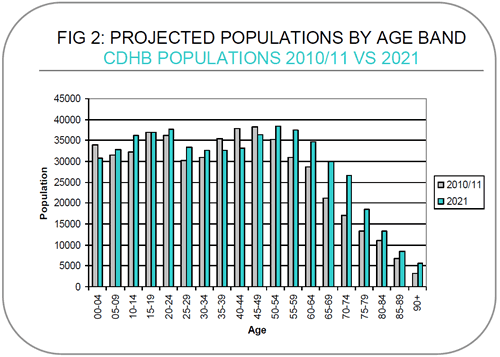
The section on demand growth builds on this. For example, it notes that:
"Assuming that we do nothing to change service delivery models, population forecasts indicate a 22% increase in medical and surgical demand by 2021."
A table of the growth in volume of key Canterbury DHB services over the last four years supports the discussion.
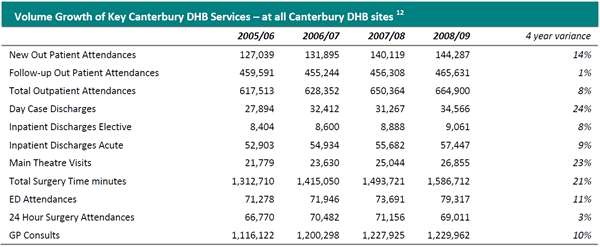
Clear strategic direction
This background information gives essential context to Canterbury DHB’s strategic direction. The SOI gives a very clear picture of the DHB’s strategic direction – it emphasises repeatedly and consistently the theme of re-orientating the health system to support a more patient-centred approach, thereby addressing the issues facing the DHB.
For example, in a section titled Unleashing Our Health System, the SOI discusses removing "artificial barriers to clinically appropriate flow". In a section setting out the DHB’s vision, it discusses further breaking down traditional boundaries and seeking to shift less complex services from hospital-based settings into primary healthcare and community settings.
Another section, titled Improving Outcomes for Our Population – What are we trying to Achieve? incorporates the previously identified strategic goals into a performance framework. Relationships between outputs, impacts, outcomes, and strategic goals are well explained.
The discussion under each strategic goal, and associated outcome measure, reinforces the earlier information. The example below is an extract from the comments under Strategic Goal 2, People Are Supported Well in their Community. It confirms the impact of the ageing population on demand for acute services, aged residential care services, and home-based support services:
"Canterbury is experiencing a growth in demand for acute (emergency or urgent) services that is faster than the growth in our population. There will be over 80,000 presentations at the Christchurch Hospital ED this year, with an equivalent number at Christchurch’s 24 hour general practice service. Population growth and the increasing age of our population are driving much of this increased demand, along with demand for Aged Residential Care (ARC) services. We have the fifth highest age-standardised per-capita utilisation of ARC services and a higher than national average utilisation of home support services."
Linkages between the medium-term picture and the forecast SSP
The clear outline of Canterbury DHB’s "transformational" approach to services in the medium-term information in the SOI helps the reader to see the linkages through to the forecast SSP. For example, when discussing the medium-term picture in the section on Unleashing Our Health System, the beneficial consequences for services are described:
"The consequence of our transformational focus has been a significant increase in productivity, as evidenced by our reductions in waiting times, increases in direct care time on wards, increases in virtual activity (such as First Specialist Assessment), increased access to services across the community (such as spirometry, sleep assessments, and skin lesion removals)…."
A number of the services referred to in the above statement have measures and targets in the forecast SSP.
Tobacco smoking
The specific example below on tobacco smoking shows the linkages between the context and outcome measures in the first part of the SOI with the discussion, impact, and output measures in the forecast SSP. The section on Health Behaviours and Risk Factors states that:
"It is tobacco smoking …that is the single most preventable cause of death. It is a major risk factor for cancer, cardiovascular disease, diabetes and respiratory disease. …Despite the prevalence of smoking amongst our population (18.3%) being lower than the national prevalence (19.9%), over 71,500 people in Canterbury were regular smokers in 2006."1
Strategic Goal 1, People Take Greater Responsibility for Their Health, has an outcome measure for smoking. The supporting narrative reiterates the significant health impacts from tobacco smoking and the graph shows trends over a five-year period for Canterbury and nationally.
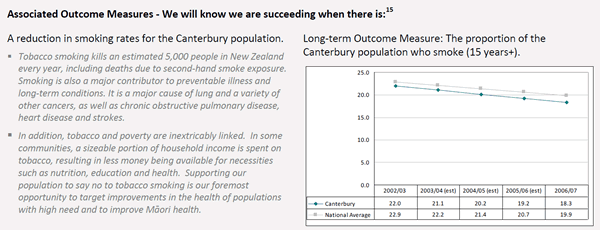
The forecast SSP has a headline impact measure presented at the start of the Child and Youth Health Services output class. It has output measures in both the Child and Youth Health Services output class and the Adult Health Services output class, under Health Promotion, Protection and Disease Prevention Services.2
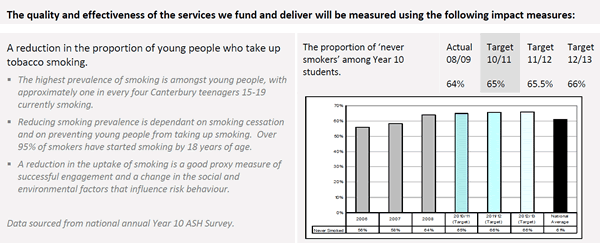
Child and Youth Health Services output class

Adult Health Services output class

Meaningful performance measures
Canterbury DHB provides trend data for its outcome and impact measures. It provides one year’s baseline data for the output measures. This comparative information helps to make the performance targets meaningful.
For a few measures, graphs display the historical performance and targets against current and forecast demographic information. This is good practice.
The example below highlights Canterbury DHB’s goal of reducing unplanned acute admissions to hospital for those aged over 65, within the context of an ageing population. The example also shows the informative narrative that accompanies the impact measures.
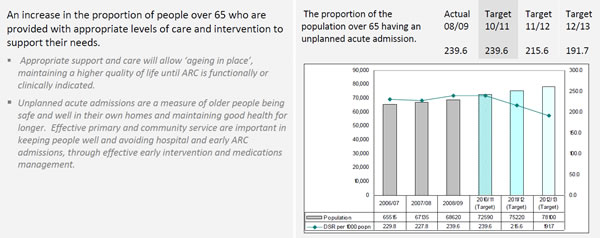
1: The SOI notes that the data for the outcome measure comes from the national NZ Health Survey collected by the Ministry of Health every three years. The survey was carried out in 2003/04 and 2006/07. Results from the 2009/10 survey are expected to be available in 2010/11.
2 Note that the "output" measures under Child and Youth Health Services are more likely to be low-level impact measures than true output measures. There are, however, also measures relating to smoking under the Adult Health Services output class – these are clearly output measures.
page top